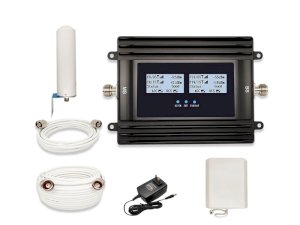
In recent years, the importance of LTE frequency bands for mobile operators in the United States and Canada has become increasingly evident. These frequency bands play a crucial role in ensuring efficient and reliable wireless communication. This article aims to provide an updated overview of the significance of LTE band, highlighting its role in facilitating seamless connectivity for users.
It is worth mentioning that this article will focus solely on USA and Canada LTE bands and exclude the discussion of 3G frequency ranges, as well as include a brief mention of the emerging 5G technology. By narrowing down the scope, we can delve into the specifics of the USA and Canada LTE bands and shed light on their importance in the telecommunications industry.
LTE frequency bands explained
Frequency generated by mobile towers is calculated by MHz (megahertz) and generally denoted with the help of one particular number. But only one numerical value can't be accurate for determining the generated frequency because one numerical value consists of several number of frequency values. As an example, 600 MHz denotes frequency bands 617 to 698 MHz.
A frequency band that is used by different network providers is marked in sequence and demonstrates sections of one particular frequency band range. A band can be shared by multiple providers or only one band is assigned to a single provider.
In some providers, you will also notice that they use multiple ranges for different places. Why do they do so? Providers use separate frequency bands in different locations to give their customers best service - a higher range for urban areas and a comparatively lower range for rural areas.
Can a mobile become compatible with a different carrier's LTE and 5G frequency bands?
In today's market, there are several popular network providers, such as Verizon, AT&T, T-Mobile, Sprint, and others, each utilizing their own unique bands to supply networks to their users. If you are considering switching to a different phone network provider, it's crucial to contact the carrier first and inquire about your device's compatibility. Many carriers lock phones to their network, so it's essential to confirm whether your device is locked or not.
To determine if your device supports the LTE and 5G frequency bands of a specific carrier, you can conveniently search online for your mobile device's specifications. It's important to review these specifications to ascertain which LTE and 5G frequency bands are compatible with your phone, ensuring optimal signal speed and performance.
If you're concerned about your phone's signal speed, it's worth exploring various internet speed apps. These apps can provide valuable insights into your internet speeds and help you monitor the efficiency and reliability of your network connection.
US LTE Bands
AT&T LTE bands
700 MHz → Bands 12, 14, 17, 29, B71
850 MHz → Band 5
1700 MHz → Bands 4, 66
1900 MHz → Band 2
2300 MHz → Band 30
Sprint LTE Bands
2300 MHz → Band 30
1900 MHz → Band 25
2500 MHz → Band 41
T-mobile LTE Bands
700 MHz → Band 12
850 MHz → Band 5
1700 MHz → Bands 4, 66
1900 MHz → Band 2
Us Cellular LTE Bands
700 MHz → Band 12
850 MHz → Band 5
1700/2100 MHz → Band 4
1900 MHz → Band 2
Verizon LTE Bands
700 MHz → Band 13
850 MHz → Band 5
1700/2100 MHz → Bands 4, 66
1900 MHz → Band 2
Boost Mobile LTE Bands
800 MHz → Band 26
1900 MHz → Band 25
2500 MHz → Band 41
US LTE Frequency Bands — Technical Insights and Characteristics (2025)
This table provides a technical overview of US LTE bands, emphasizing the coexistence and overlay of 5G technologies such as DSS and NSA, and explains the role of carrier aggregation and band-specific use cases to optimize coverage and capacity.
| Frequency (MHz) | LTE Band | Technology Support | Key Characteristics and Usage |
|---|---|---|---|
| 600 | Band 71 | LTE, 5G DSS | Improved rural coverage with low-frequency band; 5G dynamic spectrum sharing adds flexibility |
| 700 | Bands 12, 13, 14, 17, 29 | LTE, VoLTE, 5G DSS | Urban and suburban coverage; good indoor penetration; critical for voice over LTE |
| 800-850 | Bands 5, 26 | LTE | Widely used for voice and LTE data; supports strong indoor coverage |
| 1700/2100 | Bands 4, 66 | LTE Advanced, Carrier Aggregation | Aggregated bands for enhanced data speed and capacity |
| 1900 | Bands 2, 25 | LTE, 5G NSA | Mid-band frequencies used for both LTE and 5G Non-Standalone implementation |
| 2300 | Band 30 | LTE | Supplementary band for capacity in high-demand regions |
| 2500 | Band 41 | LTE-U, 5G TDD | High-capacity urban deployments; supports unlicensed LTE and 5G time-division duplexing |
Canada LTE Bands
Bell LTE Bands
700 MHz → Bands 12, 13, 17, 29
850 MHz → Band 5
1700/2100 MHz → Band 4
1900 MHz → Band 2
2600 MHz → Band 7
Rogers Wireless LTE Bands
700 MHz → Bands 12
1700/2100 MHz→ Band 4
2600 MHz → Band 7
Telus LTE Bands
700 MHz → Bands 13, 17, 29
850 MHz → Band 5
AWS → Band 4
1900 MHz → Band 2
2600 MHz → Band 7
Canadian LTE Frequency Bands — Technology and Deployment Highlights (2025)
The table highlights the key LTE frequency bands used in Canada and their technological aspects. It underscores technologies like LTE Advanced and DSS that facilitate seamless integration of LTE and 5G networks, addressing both urban high-traffic areas and rural coverage.
| Frequency (MHz) | LTE Bands | Technologies Supported | Key Advantages and Deployment Notes |
|---|---|---|---|
| 700 | Bands 12, 13, 17, 29 | LTE, 5G DSS | Extensive rural and urban coverage; supports transition to 5G with dynamic spectrum use |
| 850 | Band 5 | LTE | Reliable indoor penetration and voice services |
| 1700/2100 (AWS) | Band 4 | LTE Advanced | Supports carrier aggregation for improved throughput |
| 1900 | Band 2 | LTE, 5G | Serves as a fundamental band for mixed LTE and emerging 5G services |
| 2600 | Band 7 | LTE Advanced, 5G | High-capacity urban deployments with fast data speeds |
Obtaining accurate information about LTE frequency bands is crucial for ensuring optimal network performance. The compatibility of LTE frequency bands plays a significant role when selecting devices or smartphones. It is essential to consider the LTE bands USA or Canada supported by your carrier when making a decision, as it directly affects the quality and speed of your wireless connection.
Moreover, it is worth noting that the deployment and evolution of LTE frequency bands and 5G technology are still ongoing in the United States and Canada. As technology continues to advance, we can expect further enhancements and expansions of LTE bands and 5G to meet the increasing demands for faster and more reliable wireless communication.
We can’t say for sure which 4g band is fastest, but staying informed about LTE frequency bands and their compatibility is vital for both network operators and consumers. By understanding and utilizing the appropriate LTE bands USA and Canada, we can ensure seamless connectivity and take full advantage of the advancements made in the telecommunications industry.
Frequently Asked Questions about LTE and 5G Bands in USA and Canada
What is Carrier Aggregation and how does it improve mobile network performance?
Carrier Aggregation combines multiple frequency bands to increase data throughput, improving speed and reliability of mobile internet connections.
How does 5G Dynamic Spectrum Sharing (DSS) work with existing LTE bands?
DSS allows LTE and 5G to coexist on the same frequency band by dynamically allocating spectrum based on demand, facilitating faster 5G rollouts without new spectrum allocation.
Can a phone locked to one carrier be used on another carrier's LTE network?
Only if the phone supports the other carrier's LTE frequency bands and if the device is unlocked. Checking device band compatibility and network locking status is essential before switching.
Which LTE bands provide better indoor coverage and why?
Lower frequency bands (e.g., 600-850 MHz) penetrate buildings better, providing more stable indoor coverage compared to higher frequency bands.
Why do carriers use multiple LTE bands instead of a single frequency?
Different bands optimize coverage and capacity in varying environments—low bands cover wider rural areas, while high bands deliver high-capacity data in dense urban areas.
How does LTE coexist with 5G during the transition period?
LTE serves as the anchor network and fallback for 5G, operating alongside it through technologies like DSS and NSA (Non-Standalone) mode, ensuring network continuity and quality






